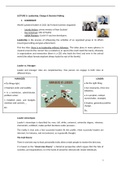Samenvatting
Detailed summary of OB Lecture 5, including the content of the physical lecture as well main explanations from the official book of the course.
- Instelling
- Tilburg University (UVT)
Detailed summary of OB Lecture 5, including the content of the physical lecture as well main explanations from the official book of the course.
[Meer zien]




